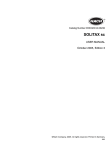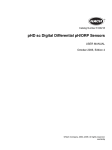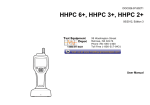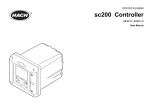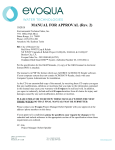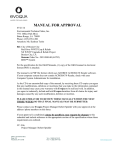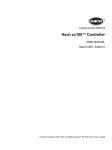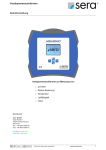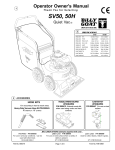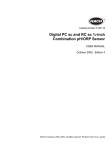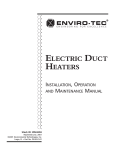Download Manual - Can-Am Instruments Ltd.
Transcript
Catalog Number 5790018 LDO™ Dissolved Oxygen Sensor USER MANUAL December 2006, Edition 6 © Hach Company, 2003–2006. All rights reserved. Printed in the U.S.A. eac/te/dp Visit http://www.hach.com Table of Contents Section 1 Specifications......................................................................................................................................... 5 Section 2 General Information ............................................................................................................................... 7 2.1 Safety Information ............................................................................................................................................... 7 2.1.1 Use of Hazard Information......................................................................................................................... 7 2.1.2 Precautionary Labels................................................................................................................................. 7 2.2 General Sensor Information ................................................................................................................................ 8 2.3 Theory of Operation ............................................................................................................................................ 8 Section 3 Installation .............................................................................................................................................. 9 3.1 Connecting/Wiring the Sensor to the sc100 Controller ....................................................................................... 9 3.1.1 Connecting the sc Sensor in a Non-hazardous Location .......................................................................... 9 3.1.1.1 Attaching a sc Sensor with a Quick-connect Fitting ......................................................................... 9 3.1.1.2 Hard-wiring a sc Sensor to the Controller ...................................................................................... 10 3.1.2 Connecting the sc Sensor to a Controller in a Hazardous Location ........................................................ 12 3.1.2.1 Attaching a sc Sensor with a Quick-connect Fitting in a Hazardous Location ............................... 12 3.2 Connecting the Sensor to the sc1000 ............................................................................................................... 13 3.2.1 Connecting the Sensor using the Quick-connect Fittings ........................................................................ 13 3.3 Installing the Sensor in the Sample Stream ...................................................................................................... 13 Section 4 User Interface and Navigation ............................................................................................................ 15 4.1 Using the sc100 Controller................................................................................................................................ 15 4.1.1 Controller Display Features ..................................................................................................................... 16 4.1.2 Important Key Presses ............................................................................................................................ 16 4.2 Using the sc1000 Controller.............................................................................................................................. 17 4.2.1 Display Features...................................................................................................................................... 17 4.2.1.1 Using the Pop-up Toolbar .............................................................................................................. 17 4.2.1.2 Using the Menu Windows .............................................................................................................. 17 4.2.1.3 Navigating the Menu Windows....................................................................................................... 18 Section 5 Operation .............................................................................................................................................. 21 5.1 Sensor Setup .................................................................................................................................................... 21 5.2 Sensor Data Logging ........................................................................................................................................ 21 5.3 Sensor Diagnostics Menu ................................................................................................................................. 21 5.4 Sensor Setup Menu .......................................................................................................................................... 22 5.5 Pressure and Elevation ..................................................................................................................................... 23 5.5.1 Selecting Atmospheric Pressure ............................................................................................................. 23 5.6 Calibration ......................................................................................................................................................... 24 5.6.1 Calibration in Air ...................................................................................................................................... 24 5.6.2 Sample Cal—Calibration by Comparison to a Winkler Titration .............................................................. 25 5.6.3 Sample Cal—Calibration by Comparison to a Hand-held DO Analyzer .................................................. 25 5.6.4 Concurrent Calibration of Two Sensors ................................................................................................... 26 Section 6 Maintenance ......................................................................................................................................... 27 6.1 Maintenance Schedule ..................................................................................................................................... 27 6.2 Cleaning the Sensor ......................................................................................................................................... 27 Section 7 Troubleshooting ................................................................................................................................... 29 7.1 Error Codes....................................................................................................................................................... 29 7.2 Warnings ........................................................................................................................................................... 29 3 Table of Contents Section 8 Replacement Parts and Accessories.................................................................................................. 31 Section 9 How to Order ......................................................................................................................................... 33 Section 10 Repair Service..................................................................................................................................... 34 Section 11 Limited Warranty ................................................................................................................................ 35 Section 10 Compliance Information .................................................................................................................... 37 4 Section 1 Specifications Specifications are subject to change without notice. Table 1 LDO Probe Specifications Components Corrosion-resistant materials, fully-immersible sensor with 10 m (30 foot) cable Measuring Range (Dissolved Oxygen) 0 to 20.00 ppm (0 to 20.00 mg/L) or 0 to 200% saturation Measuring Range (Temperature) 0 to 50 °C (32 to 122 °F) Measurement Accuracy Below 1 ppm: ± 0.1; Above 1 ppm: ±0.2 Temperature Accuracy ±0.2 °C Repeatability ±0.5% of span Response Time To 90% in less than 40 seconds To 95% in less than 60 seconds Resolution Below 10 ppm: ±0.07 ppm or mg/L, ±0.1% saturation Above 10 ppm: ±0.01 ppm or mg/L, ±0.1% saturation Interferences No interferences from the following: H2S, pH, K+1, Na+1, Mg+2, Ca+2, NH4+1, Al+3, Pb+2, Cd+2, Zn+2, Cr (tot), Fe+2, Fe+3, Mn+2, Cu+2, Mi+2, Co+2, CN–1, NO3–1, SO4–2, S–2, PO4+3, Cl–1, Anion Active Tensides, Crude Oils, Cl2–1 Probe Operating Temperature 0 to 50 °C (32 to 122 °F) Probe Storage Temperature –20 to 70 °C (–4 to 158 °F); 95% relative humidity, non-condensing. Minimum Flow Rate Non required Sensitivity ±0.5% of span Calibration/Verification Air Calibration: one point, 100% water saturated air; Sample Calibration: comparison to standard instrument, or comparison to Winkler Titration method Probe Immersion Depth and Pressure Limits Submersible to 107 m (350 ft)/1050 kPa (150 psi) Sensor Interface Modbus Sensor Cable 10 m (30 ft) integral cable with quick-disconnect type plug. Additional cable length may be added by using a junction box. Up to 100 m with extension cables. Up to 1000 m using the Junction box. Probe Weight 1.4 kg (3 lb, 2 oz.) Probe Dimensions 60 x 292 mm (2.4 x 11.5 inch) Warranties Probe: 3 years Sensor Cap: 1 year 5 Visit us at www.hach.com Section 2 General Information 2.1 Safety Information Please read this entire manual before unpacking, setting up, or operating this equipment. Pay attention to all danger and caution statements. Failure to do so could result in serious injury to the operator or damage to the equipment. To ensure that the protection provided by this equipment is not impaired, do not use or install this equipment in any manner other than that specified in this manual. This product is acceptable for use in a Hazardous Location when used with an sc100 Controller and installed per Control Drawing 5860078 as described in the sc100 Controller Manual, Cat. No. 5860018. 2.1.1 Use of Hazard Information DANGER Indicates a potentially or imminently hazardous situation which, if not avoided, could result in death or serious injury. CAUTION Indicates a potentially hazardous situation that may result in minor or moderate injury. Important Note: Information the requires special emphasis. Note: Information that supplements points in the main text. 2.1.2 Precautionary Labels Read all labels and tags attached to the instrument. Personal injury or damage to the instrument could occur if not observed. This symbol, if noted on the instrument, references the instruction manual for operation and/or safety information. This symbol, when noted on a product enclosure or barrier, indicates that a risk of electrical shock and/or electrocution exists. This symbol, if noted on the product, indicates the need for protective eye wear. This symbol, when noted on the product, identifies the location of the connection for Protective Earth (ground). This symbol, when noted on the product, identifies the location of a fuse or current limiting device. 7 General Information 2.2 General Sensor Information The Luminescent Dissolved Oxygen (LDO) Sensor (Figure 1) allows aqueous samples to be easily and accurately analyzed for dissolved oxygen concentration. Specially designed for municipal and industrial wastewater applications, the system consists of a controller with an integrated display, and a sensor (probe with sensor cap) for in-situ measurement. The LDO sensor can be operated using the sc100 controller and the sc1000 controller. Refer to Operation on page 15 and sc1000 Operation on page 25 for more information. Optional equipment, such as mounting hardware for the sensor, is supplied with an instruction sheet for all user installation tasks. Several mounting options are available, allowing the sensor to be adapted for use in many different applications. Typical applications include aeration basins, nutrient removal in equalization basins, aerobic and anaerobic digesters, effluent streams, rivers, lakes, and fish ponds. Figure 1 LDO Sensor Dimensions 2.3 Theory of Operation The sensor in the cap is coated with a luminescent material. Blue light from an LED illuminates the luminescent chemical on the surface of the sensor cap. The luminescent chemical instantly becomes excited and then as the excited chemical relaxes, it releases red light. The red light is detected by a photodiode and the time it takes for the chemical to return to a relaxed state is measured. The higher the oxygen concentration, the less red light is given off by the sensor and the shorter time it takes for the luminescent material to return to a relaxed state. The oxygen concentration is inversely proportional to the time it takes for the luminescent material to return to a relaxed state. Unlike electrochemical dissolved oxygen sensor technologies, the Luminescent Dissolved Oxygen (LDO) sensor does not consume oxygen. It does not require frequent recalibration or frequent cleaning (except when associated with consumptive slimes), resulting in longer sensor life and more stable and accurate readings. The system is also flow-independent so measurements can be made in applications with low or no flow. 8 Section 3 Installation DANGER Only qualified personnel should conduct the tasks described in this section of the manual. DANGER Seul un technicien qualifié peut effectuer les tâches d'installation décrites dans cette section du manuel. The LDO system can be used with either an sc100 or sc1000 controller. Refer to section 3.1 for sc100 installation instructions and section 3.2 on page 13 for sc1000 installation instructions. 3.1 Connecting/Wiring the Sensor to the sc100 Controller DANGER The sc100 and certain versions of the sensor are suitable for use in Class 1, Division 2, Groups A, B, C, D Hazardous Locations . See Control Drawing 5860078 in the sc100 Controller Manual, Cat. No. 5860018 for acceptable sensor versions and installation requirements. DANGER Le sc100 et certaines versions du capteur peuvent être utilisés dans des endroits dangereux de la Classe 1, Division 2, Groupes A, B, C, D. Reportez-vous au schéma de contrôle 5860078 du Manuel du contrôleur sc100, Réf. 5860018 pour connaître les versions des capteurs admises et les conditions d'installation. 3.1.1 Connecting the sc Sensor in a Non-hazardous Location 3.1.1.1 Attaching a sc Sensor with a Quick-connect Fitting Important Note: The standard quick-connect fitting is NOT suitable for Class 1, Division 2 Hazardous Location installations without the connector lock installed, see section 3.1.2 on page 12 for more information. The sensor cable is supplied with a keyed quick-connect fitting for easy attachment to the controller (Figure 2). Retain the connector cap to seal the connector opening in case the sensor must be removed. Optional extension cables may be purchased to extend the sensor cable length. If the total cable length exceeds 100 m (300 ft), a termination box must be installed. Note: Use of a load termination box other than Cat. No. 5867000 may result in a hazard. The load termination box cannot be used in a hazardous location. 9 Installation Figure 2 Attaching the Sensor using the Quick-connect Fitting 3.1.1.2 Hard-wiring a sc Sensor to the Controller Important Note: Hard-wiring the sensor to the sc100 is not an approved method for Class I, Division 2 Hazardous Locations. 1. Disconnect power to the controller if powered. 2. Open the controller cover. 3. Disconnect and remove the existing wires between the quick-connect and terminal strip J5, see Figure 3 on page 11. 4. Remove the quick-connect fitting and wires and install the threaded plug on the opening to maintain the environmental rating. 5. Cut the connector from the sensor cable. 6. Strip the insulation on the cable back 1-inch. Strip ¼-inch of each individual wire end. 7. Pass the cable through conduit and a conduit hub or a strain relief fitting (Cat. No. 16664) and an available access hole in the controller enclosure. Tighten the fitting. Note: Use of strain relief fitting other than Cat. No. 16664 may result in a hazard. Use only the recommended strain relief fitting. 8. Reinstall the plug on the sensor access opening to maintain the environmental rating. 9. Wire as shown in Table 2 and Figure 3. 10. Close and secure the cover. 10 Installation Table 2 Wiring the Sensor at Terminal Block J5 Terminal Number Terminal Designation Wire Color 1 Data (+) Blue 2 Data (–) White 3 Service Request No Connection 4 +12 VDC Brown 5 Circuit Common Black 6 Shield Shield (grey wire in existing quick-disconnect fitting) Figure 3 Hard-wiring the Sensor J1 J3 S1 U9 ANALOG OUTPUTS J4 J5 PCB CONNECTOR NETWORK INTERFACE CARD NC COM NO RELAY 1 NC COM NO RELAY 2 1 2 3 4 5 6 + DATA 1 2 3 4 5 + OUT 2 – DATA SERVICE REQUEST +V GND F1 U5 F2 PROBES J2 – OUT 2 SHIELD/CHASSIS GND + OUT 1 – OUT 1 NC COM NO RELAY 3 DANGER - EXPLOSION HAZARD DO NOT DISCONNECT WHILE CIRCUIT IS LIVE UNLESS AREA IS KNOWN TO BE NON-HAZARDOUS. J6 DANGER - RISQUE D'EXPLOSION NE PAS DEBRANCHER TANT QUE LE EST SOUS TENSION, A MONIS QU'IL NE S'AGISSE D'UN EMPLACEMENT NON-DANGEROUX FIELD WIRING INSULATION MUST BE RATED TO 80° C MINIMUM Disconnect Power From Probe 11 Installation 3.1.2 Connecting the sc Sensor to a Controller in a Hazardous Location DANGER The sc100 and certain versions of the sensor are suitable for use in Class 1, Division 2, Groups A, B, C, D Hazardous Locations . See Control Drawing 5860078 in the sc100 Controller Manual, Cat. No. 5860018 for acceptable sensor versions and installation requirements. DANGER Le sc100 et certaines versions du capteur peuvent être utilisés dans des endroits dangereux de la Classe 1, Division 2, Groupes A, B, C, D. Reportez-vous au schéma de contrôle 5860078 du Manuel du contrôleur sc100, Réf. 5860018 pour connaître les versions des capteurs admises et les conditions d'installation. DANGER Explosion hazard. Do not connect or disconnect equipment unless power has been switched off or the area is known to be non-hazardous. DANGER Risque d’explosion. Couper le courant ou s’assurer que l’emplacement est designe non dangereux avant de replacer le aucon composant. 3.1.2.1 Attaching a sc Sensor with a Quick-connect Fitting in a Hazardous Location The sensor cable is supplied with a keyed quick-connect fitting for easy attachment to the controller, see Figure 2. For hazardous locations, a connector safety lock (Cat. No. 6139900) must be installed. Retain the connector cap to seal the connector opening in case the sensor must be removed. Important Note: The load termination box (Cat. No. 5867000) cannot be used in a hazardous location. 1. Remove the connector cap from sc100 controller. Retain the connector cap to seal the connector opening in case the sensor must be removed. 2. Connect the sensor connector to the plug on the sc100. 3. Install a connector safety lock (Figure 4). Align the lock over the connector and squeeze the two halves together to lock. To remove the connector safety lock by inserting a small flat-bladed screwdriver into the locking groove. Pivot the screwdriver away from the groove and separate the two halves (Figure 4). Figure 4 Installing the Connector Safety Lock 38.1 mm (1.50 inches) 38.1 mm (1.50 inches) 12 Installation 3.2 Connecting the Sensor to the sc1000 3.2.1 Connecting the Sensor using the Quick-connect Fittings 1. Unscrew the connector cap from the controller. Retain the connector cap to seal the connector opening in case the sensor must be removed. 2. Push the connector into the socket. 3. Hand-tighten the union nut. Note: Do not use the middle connection for the sensors as this is reserved for the display module. 3.3 Installing the Sensor in the Sample Stream To install the LDO in a sample stream, it is recommended to use either the optional pole mount (Cat. No. 5794400) or ball float mount (Cat. No. 5794300) as shown in Figure 5. Please refer to the instruction sheets provided with these mounting kits for more detailed information. 13 Installation Figure 5 Optional Pole Mount (Cat. No. 5794400) and Ball Float Mount (5794300) Installation 1 1 3 2 aa aa aa aa aa aa aa aa aa 5 4 1. Pipe locking knob 4. Position pin removed for float assembly 2. Pipe locking knob 5. Adjustable angle (using position pin) 3. Position pin 14 aa aa aa aa aa aa aa aa aa Section 4 User Interface and Navigation 4.1 Using the sc100 Controller The front of the controller is shown in Figure 6. The keypad consists of the eight keys described in Table 3. Figure 6 Front of the Controller 1 sc100 5 2 6 3 7 4 1. Instrument display 5. IrDA window 2. BACK key 6. HOME key 3. MENU key 7. ENTER key 4. RIGHT, LEFT, UP, and DOWN keys Table 3 Controller Key Functions/Features Number Key Function 2 Moves back one level in the menu structure. 3 Moves to the main menu from other menus. This key is not active in menus where a selection or other input must be made. 4 Navigates through the menus, changes settings, and increments and decrements digits. 5 Moves to the Main Measurement screen from any other screen. This key is not active in menus where a selection or other input must be made. 6 Accepts an input value, updates, or accepts displayed menu options. 15 User Interface and Navigation 4.1.1 Controller Display Features When a sensor is connected and the controller is in measurement mode, the controller automatically identifies the connected sensors and displays associated measurements. The display will flash on startup, when a sensor error has occurred, and when a sensor is being calibrated. An active system warning will cause the warning icon (a triangle with an exclamation point inside) to be displayed on the right side of the display. See Figure 7. Figure 7 Display SENSOR NAME: 1 4 7.00 2 5 pH 6 TEMP: 23.0°C 3 1. Status bar. Indicates the sensor name and status of relays. The relay letter is displayed when the relay is energized. 4. Parameter 2. Main measurement 5. Warning icon area 3. Secondary measurement (if applicable) 6. Measurement units 4.1.2 Important Key Presses • Press HOME then the RIGHT or LEFT key to display two readings when two sensors are connected. Continue to press the RIGHT or LEFT key to toggle through the available display options as shown below. • Press the UP and DOWN keys to toggle the status bar at the bottom of the measurement display to display the secondary measurement (temperature) and output information. SENSOR NAME: 7.00 TEMP: 23.0°C • pH 7.00 SENSOR NAME: pH pH OUTPUT1: 12.00 mA 7.00 pH pH OUTPUT2: 12.00 mV When in Menu mode, an arrow may appear on the right side of the display to indicate that more menus are available. Press the UP or DOWN key (corresponding to the arrow direction) to display additional menus. MAIN MENU SENSOR DIAG SENSOR SETUP SYSTEM SETUP TEST/MAINT 16 SENSOR NAME: pH SYSTEM SETUP OUTPUT SETUP RELAY SETUP NETWORK SETUP DISPLAY SETUP SYSTEM SETUP DISPLAY SETUP SECURITY SETUP LOG SETUP CALCULATION SYSTEM SETUP SECURITY SETUP LOG SETUP CALCULATION ERROR HOLD MODE User Interface and Navigation 4.2 Using the sc1000 Controller The sc1000 is a touch screen application. Use your finger to touch keys and menu commands. In normal operation the touch screen displays the measured values for the sensors selected. 4.2.1 Display Features 4.2.1.1 Using the Pop-up Toolbar The pop-up toolbar provides access to the controller and sensor settings. The toolbar is normally hidden from view. To view the toolbar, touch the bottom-left of the screen. Figure 8 Pop-up Toolbar Functions 1 2 4 MAIN MENU–displays the Main Menu Structure UP Arrow–scrolls up to the previous displayed value. 1 Displays one value. 2 Displays two values at the same time. 4 Displays four values at the same time. LIST–displays the list of connected devices and sensors. DOWN Arrow–scrolls down to the next displayed value. 4.2.1.2 Using the Menu Windows If the Menu button (from the pop-up toolbar) is selected, the Main Menu screen is opened. The Main Menu screen allows the user to view the sensor status, configure the sensor setup, system setup, and perform diagnostics. The menu structure may vary depending on the configuration of the system. 17 User Interface and Navigation Figure 9 Main Menu 3 2 4 5 MENU SENSOR STATUS 1 6 SENSOR SETUP SYSTEM SETUP TEST/MAINT 7 1. Display Area 2. BACK 3. FORWARD 4. ENTER–confirms the entry or selection. 5. HOME–changes to the display of measured values. The pop-up toolbar cannot open from the menu window. To view the Main Menu from this display, touch the Home button and then the bottom of the screen. 6. UP–scrolls up 7. DOWN–scrolls down 4.2.1.3 Navigating the Menu Windows To view a menu item, touch the menu item or use the UP and DOWN keys to highlight the item. The menu item remains highlighted for approximately 4 seconds after it is selected. To view the highlighted command, select the area to the left of the menu item or select the ENTER button. A “+” next to a menu command indicates there is a submenu. Touch the “+” to view the submenu. An “i” next to a menu command indicates it is information only. If a menu item is editable, highlight the item and touch the far-left part of the menu item until it is highlighted and press ENTER or double-tap the highlighted item. A keypad will be displayed to change an entry (Figure 11 on page 19) or a list box will be displayed (Figure 12 on page 20). Messages are displayed in the message window (Figure 13 on page 20). If an entry is incorrect, repeat the entry with the correct values. If the entry is outside the working range, a correction to the entry is made automatically. 18 User Interface and Navigation Figure 10 Changing a Menu Item 1. Display Area 5. HOME–changes to the display of measured values. 2. BACK 6. UP–scrolls up 3. FORWARD 7. DOWN–scrolls down 4. ENTER–confirms the entry or selection. Figure 11 Keypad 1 2 3 1 2 3 : 4 4 5 6 / 5 7 8 9 0 6 1. Enters numbers or the character as shown on the button. 2. Moves the cursor one position to the left or to the right. 3. Increase/Decrease a number or letter at the cursor position. Keep the button pressed to change the numbers/characters continuously. 4. Deletes the character to the left of the cursor. 5. CANCEL–cancels the entry. 6. ENTER–confirms the entry or selection. 19 User Interface and Navigation Figure 12 List Box 1 mg/l g/l ppm mE E m-1 FNU NTU 1. Scrolls up or down 2. CANCEL–cancels and entry. 3. ENTER–confirms a selection. Figure 13 2 3 Message window 1 2 4 COMMUNICATION ERROR 5 Ph [11f20030007] 6 1. Scrolls up or down. 2. Displays the messages or warnings. 3. Displays details on the selected entry. 4. This button changes back to the previous display. 5. ENTER–confirms an entry. 6. CANCEL–cancels an entry. 20 3 Section 5 Operation 5.1 Sensor Setup When a sensor is initially installed, the serial number of the Digital Gateway will be displayed as the sensor name. To change the sensor name refer to the following instructions: 1. Select Main Menu. 2. From the Main Menu, select SENSOR SETUP and confirm. 3. Highlight the appropriate sensor if more than one sensor is attached and confirm. 4. Select CONFIGURE and confirm. 5. Select EDIT NAME and edit the name. Confirm or cancel to return to the Sensor Setup menu. 5.2 Sensor Data Logging The sc1000 controller provides a data log for each sensor. The sc100 provides three data logs (one for each sensor and one for calculated values) and three event logs (one for each sensor and one for the controller). The data logs store the measurement data at selected intervals. The event log stores a variety of events that occur on the devices such as alarms and warning conditions. The data logs are stored in a packed binary format and the event logs are stored in a CSV format. The logs can be downloaded through the digital network port, service port, or the IrDA port. DataCom is needed for downloading logs to a computer. 1. From the Main Menu, select SENSOR SETUP and confirm. 2. Highlight the appropriate sensor if more than one sensor is attached and confirm. 3. Select CONFIGURE and confirm. 4. Select LOG SETUP and cofirm. 5. Select from the logging interval options from the list box and confirm. 5.3 Sensor Diagnostics Menu SELECT SENSOR ERROR LIST—See section 7.1 on page 29. WARNING LIST—See section 7.2 on page 29. 21 Operation 5.4 Sensor Setup Menu SELECT SENSOR (if more than one sensor is attached) CALIBRATE AIR CAL Perform an air calibration of the sensor (slope calibration). See section 5.6.1 on page 24. SAMPLE CAL Enter a value for the DO concentration as determined by another sensor or independent method. The instrument performs an offset calibration based on the entered value. See section 5.6.2 on page 25 and section 5.6.3 on page 25. SET CAL DEFLT Restores the gain and offset values to 1.0 and 0.0, respectively, and restores the Sensor Cap Code to default. CONFIGURE EDIT NAME Enter up to a 10-digit name in any combination of symbols and alpha or numeric characters. ALT/PRESS UNITS Choose pressure units in feet, meters, mm Hg, or torr. ALT/PRESS Enter either altitude or air pressure. Correlates to the pressure units setting. Range: –5000 to 15000 Note: The Alt/Press setting must be correct for proper measurement of % saturation and proper operation of air calibration. TEMP UNITS Select Celsius or Fahrenheit. MEAS UNITS Select the appropriate measurement units to display. Choose from: mg/L, ppm, or percent. SALINITY User-entered value. Range: 0.00–250.00 parts per thousand salinity SENSOR CODE Enter the unique code supplied with each sensor cap. The code ensures the preprogrammed factory calibration is adjusted for each sensor cap. The code consists of either 10-digits or 3-digits followed by a period. The period following the three digit code must be entered to complete the code entry. SET DEFAULTS Resets the sensor configuration to default settings. SIGNAL AVE Averages readings over a specified time interval. Default is 60 sec. Increase response by decreasing the time interval. Fastest response is at 0 sec. LOG SETUP Allows user to select data logging interval of DO and temperature readings. 22 Operation 5.4 Sensor Setup Menu (continued) DIAG/TEST SOFTWARE VERS. Displays the software version number DRIVER VERS Displays the software driver version number. GAIN CORR User Editable—to change the calibration gain. Range: 0.000–3.0 OFFSET CORR User Editable—to change the calibration offset. Range: -3.0–3.0 PHASE DIAG Information only—updated once per second AMPL DIAG Information only—updated once per second SERIAL NUMBER Serial number of the sensor 5.5 Pressure and Elevation Note: If the barometric pressure from Table 4 is entered in the meter, the altitude entered in combination with this value must be 0 feet. Table 4 can be used to estimate the true barometric pressure at certain elevations. The correspondence is based on the assumption that at sea level the barometric pressure is 760 mm Hg. After determining the barometric pressure from the table or obtaining it from a local weather service, enter this value into the instrument, see section 5.6.1 on page 24. 5.5.1 Selecting Atmospheric Pressure 1. From the Main Menu, select SENSOR SETUP and confirm. 2. Select the appropriate sensor if more than one is attached and confirm. 3. Select CONFIGURE and confirm. 4. Select AIR PRESS/ALT UNITS. Select the appropriate units and confirm. 5. Select AIR PRESS/ALT. Change the value using the keypad and confirm the selection. Note: AirPress/Alt must be correct for proper measurement of % saturation and operation of air calibration. Table 4 Elevation Barometric Pressure Elevation in feet Barometric pressure in mm Hg Elevation in feet Barometric pressure in mm Hg 0 760 6000 613 500 746 6500 601 23 Operation Table 4 Elevation Barometric Pressure Elevation in feet Barometric pressure in mm Hg Elevation in feet Barometric pressure in mm Hg 1000 733 7000 590 1500 720 7500 579 2000 708 8000 568 2500 695 8500 559 3000 683 9000 548 3500 671 9500 538 4000 659 10000 527 4500 647 10500 517 5000 635 11000 506 5500 624 — — 5.6 Calibration The dissolved oxygen sensor has been calibrated at the factory to the specifications listed on Specifications on page 5. Due to the inherent accuracy and stability of the luminescent dissolved oxygen technology, sensor calibration is seldom or never necessary. The calibration procedures will result in an instrument offset or gain correction and may be performed if required by regulatory agencies. The air calibration is the most accurate method. The calibration by comparison method is the least accurate and is therefore not recommended. For continued accuracy and repeatability, the manufacturer recommends replacing the sensor cap after one year of operation. 5.6.1 Calibration in Air 1. Remove the sensor from the process stream and wipe with a wet cloth to remove debris and biological growth. 2. Place the sensor in the supplied Calibration Bag, add a small amount of water (25–50 mL) and secure the bag to the sensor body. 3. Lay the bagged probe on a flat surface where it will not be exposed to a heat source. 4. From the Main Menu, select SENSOR SETUP and confirm. 5. Select the appropriate sensor if more than one is attached and confirm. 6. Select CALIBRATE and confirm. 7. Select AIR CAL. Select the available Output Mode (Active, Hold, or Transfer) from the list box and confirm. 8. “Move the sensor to air” will be displayed if the sensor is moved to air (in the calibration bag). 9. The Air Calibration procedure will begin and “Wait to Stabilize” will be displayed. The current DO and temperature readings will be displayed. Confirm. 10. The calibration will automatically occur when the reading stabilizes or when the reading is confirmed to base the calibration on the currently displayed value. Two to 24 Operation three minutes for the reading to stabilize is typical, however, if it has not stabilized after 45 minutes, the display will ready “Unable to Calibrate”. After calibration, one of the responses in Table 5 on page 26 will be displayed. 11. Follow the prompts to return the sensor to the process. 5.6.2 Sample Cal—Calibration by Comparison to a Winkler Titration 1. From the Main Menu, select SENSOR SETUP and confirm. 2. Select the appropriate sensor if more than one is attached and confirm. 3. Select CALIBRATE and confirm. 4. Select SAMPLE CAL. Select the available Output Mode (Active, Hold, or Transfer) from the list box and confirm. Note: An output that has been placed in Hold or Transfer status will be automatically released when the calibration is complete. 5. Remove the sensor from the process stream and gently wipe with a wet cloth to remove all debris and biological growth. Remaining debris will affect the Winkler Method of analysis. 6. Measure 1000 mL of deionized water. Allow the water to come to the thermal and dissolved oxygen equilibrium (approximately 20 minutes). 7. Fill a standard BOD bottle and then place the sensor in a beaker containing the remainder of the deionized water. 8. Perform the Winkler Tritration using Cat. No. 146900 Winkler Test Kit on the deionized water in the BOD bottle while waiting for the process sensor to stabilize. 9. Move the sensor to the sample. 10. The display will show “Press ENTER when Stabilized” and the current DO and temperature readings. When the reading is confirmed or when the reading has been accepted as stable, the display will change to an entry screen. If ENTER is not pressed, the sensor will determine when the reading is stable. Two to three minutes for the reading to stabilize is typical, however, if it has not stabilized after 45 minutes, the display will show “Unable to Calibrate”. 11. When a stable reading has been accepted, the display will show “Sample Cal” and an area for entry of the value obtained from the comparison method. When the entry screen is displayed, enter the value from the hand-held or winkler titration and confirm. 12. After calibration, one of the responses in Table 5 on page 26 will be displayed. 5.6.3 Sample Cal—Calibration by Comparison to a Hand-held DO Analyzer 1. Place the dissolved oxygen sensor as close to the LDO sensor as possible. 2. Wait for the hand-held DO analyzer to stabilize. 3. From the Main Menu, select SENSOR SETUP and confirm. 4. Select the appropriate sensor if more than one is attached and confirm. 25 Operation 5. Select CALIBRATE and confirm. 6. Select SAMPLE CAL. Select the available Output Mode (Active, Hold, or Transfer) from the list box and confirm. 7. The display will show “Press ENTER when Stabilized” and the current DO and temperature readings. When the reading has been confirmed or when the reading has been accepted as stable, the display will change to an entry screen. If ENTER is not pressed, the sensor will determine when the reading is stable. Two to three minutes for the reading to stabilize is typical, however, if it has not stabilized after 45 minutes, the display will show “Unable to Calibrate”. 8. When a stable reading has been accepted, the display will show “Sample Cal” and an area for entry of the value obtained from the Winkler Titration. 9. Change the displayed reading to match the hand-held DO analyzer memory. 10. After calibration, one of the responses in Table 5 on page 26 will be displayed. 5.6.4 Concurrent Calibration of Two Sensors 1. Begin a calibration on the first sensor and proceed when “Wait to Stabilize” is displayed. 2. Select the BACK arrow, then LEAVE. The display will return to the Main Measurement screen. 3. Begin the calibration for the second sensor and continue until “Wait to Stabilize” is displayed. 4. Select the BACK arrow, then LEAVE. The display will return to the Main Measurement screen and the reading for both sensors will be flashing. 5. To return to the calibration of either sensor, select the Main Menu button. Select SENSOR SETUP and confirm. Select the appropriate sensor and confirm. 6. The calibration in progress will be displayed. Continue with the calibration. Table 5 Calibration Response Calibration Response Explanation Cal Complete Indicates the Calibration is complete. Cal Fail, Offset HIgh Indicates the air calibration has failed due to an excessively high calculated gain value. Repeat the calibration. Cal Fail, Offset Low Indicates the air calibration has failed due to too low of a calculated gain value. Repeat the calibration. Cal Fail, Unstable Indicates the air calibration has failed because the readings did not stabilize during the maximum allowed calibration time interval. Repeat the calibration. 26 Section 6 Maintenance DANGER Only qualified personnel should conduct the tasks described in this section of the manual. DANGER Seul un technicien qualifié peut effectuer les tâches d'installation décrites dans cette section du manuel. DANGER Explosion hazard. Do not connect or disconnect equipment unless power has been switched off or the area is known to be non-hazardous. DANGER Risque d’explosion. Couper le courant ou s’assurer que l’emplacement est designe non dangereux avant de replacer le aucon composant. DANGER Explosion hazard. Substitution of components may impair suitability for Class 1, Division 2. DANGER Risque d’explosion. La substitution de composants peut rendre ce materiel inacceptable pour les emplacements de Classe 1, Division 2. 6.1 Maintenance Schedule Maintenance Task 90 days Clean the sensor1 x Inspect sensor cap for damage x Calibrate Sensor (if required by regulatory agency) 1 Annually Per the schedule mandated by your regulatory agency. Cleaning frequency is application dependent. More or less frequent cleaning will be appropriate in some applications. 6.2 Cleaning the Sensor Clean the exterior of the sensor with a soft, wet cloth. If the sensor cap is removed from the sensor body, do not leave the interior of the cap exposed to sunlight. Sun exposure to the interior of the cap can adversely affect the performance of the sensor. Degradation from sunlight is only an issue if the sensor cap is off the sensor body and the interior of the sensor cap is exposed to sunlight. 27 Visit us at www.hach.com Section 7 Troubleshooting 7.1 Error Codes When a sensor is experiencing an error condition, the sensor reading on the measurement screen will flash and all relays and analog outputs associated with this sensor will be held. The following conditions will cause the sensor reading to flash: Sensor calibration, Relay timer washing cycle, Loss of communication. Highlight the Sensor Diag menu and press ENTER. Highlight Errors and press ENTER to determine the cause of the error. Errors are defined in Table 6. Table 6 Error Codes Displayed Error Definition Resolution RED AMPL LOW1 Sensor cap not installed or not installed correctly. Light path is blocked inside the sensor cap. Sensor not operating properly. Remove and reinstall sensor cap. Check for blockage inside the sensor cap. Ensure red LED is flashing. Contact the Service Department. BLUE AMPL LOW Sensor not operating properly. Contact the Service Department. Remove and reinstall sensor cap. Check for blockage inside the sensor cap. Ensure blue LED is flashing. Contact the Service Department. 1 To determine the amplitude values: a. Start from the main menu, highlight Sensor Setup and press ENTER. b. Highlight the correct sensor and press ENTER. c. Highlight Diag/Test and press ENTER. d. Highlight Ampl Diag and press ENTER. The Amplitude of the red and blue LEDs are shown. The LEDs transmit light onto the inner surface of the sensor cap and the light is reflected back down to the detector inside the sensor. The amplitude increases as more light is reflected. Typical values are from 0.1 to 0.5. The alarm/warning occurs at 0.01/0.03. 7.2 Warnings A Sensor warning will leave all menus, relays, and outputs functioning normally, but will cause a warning icon to flash on the right side of the display. Highlight the Sensor Diag menu and press ENTER to determine the cause of the warning. A warning may be used to trigger a relay and users can set warning levels to define the severity of the warning. Warnings are defined in Table 7. 29 Troubleshooting Table 7 Warning Codes Displayed Warning Definition Resolution EE SETUP ERR The EEPROM was corrupted. Values have been set to factory defaults. Contact the Service Department. EE RSRVD ERR The EEPROM was corrupted. Values have been set to factory defaults. Contact the Service Department. TEMP < 0 C The sensed temperature is below 0 °C (32 °F). Increase process temperature or discontinue use until the process temperature is above 0 °C (32 °F). TEMP > 50 C The sensed temperature is above 50°C (120 °F). Decrease process temperature or discontinue use until the process temperature is below 50 °C (120 °F). RED AMPL LOW Sensor cap not installed or not installed correctly. Sensor not operating properly. Remove and reinstall sensor cap. Contact the Service Department. RED AMPL HIGH Sensor cap not installed or not installed correctly. Sensor not operating properly. Remove and reinstall sensor cap. Contact the Service Department. BLUE AMPL LOW Sensor cap not installed or not installed correctly. Sensor not operating properly. Remove and reinstall sensor cap. Contact the Service Department. BLUE AMPL HIGH Sensor cap not installed or not installed correctly. Sensor not operating properly. Remove and reinstall sensor cap. Contact the Service Department. 30 Section 8 Replacement Parts and Accessories Replacement Items Description QTY Cat. No. Instruction manual, LDO System, English each 5790018 LDO Probe with one sensor cap and 5 calibration bags each 5790000 LDO Probe with one sensor cap and 5 calibration bags, Hazardous Locations each 5790001 Sensor cap, replacement each 5791100 Description QTY Cat. No. Air blast cleaning system, 115 V each 5795100 Air blast cleaning system, 230 V (non-hazardous locations only) each 5795200 High Output Air Blast Cleaning System, 115 V each 6170000 High Output Air Blast Cleaning System, 250 V each 6170100 5 bags 5796605 Accessories Calibration bags Cable, sensor extension, non-hazardous locations, 7.7 m (25 ft) each 5796000 Cable, sensor extension, non-hazardous locations, 15 m (50 ft) each 5796100 Cable, sensor extension, non-hazardous locations, 31 m (100 ft) each 5796200 Cable, sensor extension, hazardous Locations, 1 m each 61224-01 Cable, sensor extension, hazardous locations, 7.7 m (25 ft) each 5796001 Cable, sensor extension, hazardous locations, 15 m (50 ft) each 5796101 Cable, sensor extension, hazardous locations, 31 m (100 ft) each 5796201 Connector Safety Lock each 6139900 Load termination box each 5867000 Mounting hardware kit, pipe each 5794400 Mounting hardware kit, ball float each 5794300 Plug, sealing, conduit opening each 5868700 Strain relief, Hayco each 16664 Winkler titration kit each 146900 31 Visit us at www.hach.com Section 9 How to Order U.S.A. Customers By Telephone: 6:30 a.m. to 5:00 p.m. MST Monday through Friday (800) 227-HACH (800-227-4224) By Fax: (970) 669-2932 By Mail: Hach Company P.O. Box 389 Loveland, Colorado 80539-0389 U.S.A. Ordering information by e-mail: [email protected] Information Required • Hach account number (if available) • Billing address • Your name and phone number • Shipping address • Purchase order number • Catalog number • Brief description or model number • Quantity International Customers Hach maintains a worldwide network of dealers and distributors. To locate the representative nearest you, send an e-mail to: [email protected] or contact: Hach Company World Headquarters; Loveland, Colorado, U.S.A. Telephone: (970) 669-3050; Fax: (970) 669-2932 Technical and Customer Service (U.S.A. only) Hach Technical and Customer Service Department personnel are eager to answer questions about our products and their use. Specialists in analytical methods, they are happy to put their talents to work for you. Call 1-800-227-4224 or e-mail [email protected] 33 Section 10 Repair Service Authorization must be obtained from Hach Company before sending any items for repair. Please contact the Hach Service Center serving your location. In the United States: Hach Company Ames Service 100 Dayton Avenue Ames, Iowa 50010 (800) 227-4224 (U.S.A. only) FAX: (515) 232-3835 In Canada: Hach Sales & Service Canada Ltd. 1313 Border Street, Unit 34 Winnipeg, Manitoba R3H 0X4 (800) 665-7635 (Canada only) Telephone: (204) 632-5598 FAX: (204) 694-5134 E-mail: [email protected] In Latin America, the Caribbean, the Far East, Indian Subcontinent, Africa, Europe, or the Middle East: Hach Company World Headquarters, P.O. Box 389 Loveland, Colorado, 80539-0389 U.S.A. Telephone: (970) 669-3050 FAX: (970) 669-2932 E-mail: [email protected] 34 Section 11 Limited Warranty Hach Company warrants its products to the original purchaser against any defects that are due to faulty material or workmanship for a period of one year from date of shipment unless otherwise noted in the product manual. In the event that a defect is discovered during the warranty period, Hach Company agrees that, at its option, it will repair or replace the defective product or refund the purchase price excluding original shipping and handling charges. Any product repaired or replaced under this warranty will be warranted only for the remainder of the original product warranty period. This warranty does not apply to consumable products such as chemical reagents; or consumable components of a product, such as, but not limited to, lamps and tubing. Contact Hach Company or your distributor to initiate warranty support. Products may not be returned without authorization from Hach Company. Limitations This warranty does not cover: • Damage caused by acts of God, natural disaster, labor unrest, acts of war (declared or undeclared), terrorism, civil strife or acts of any governmental jurisdiction • Damage caused by misuse, neglect, accident or improper application or installation • Damage caused by any repair or attempted repair not authorized by Hach Company • Any product not used in accordance with the instructions furnished by Hach Company • Freight charges to return merchandise to Hach Company • Freight charges on expedited or express shipment of warranted parts or product • Travel fees associated with on-site warranty repair This warranty contains the sole express warranty made by Hach Company in connection with its products. All implied warranties, including without limitation, the warranties of merchantability and fitness for a particular purpose, are expressly disclaimed. Some states within the United States do not allow the disclaimer of implied warranties and if this is true in your state the above limitation may not apply to you. This warranty gives you specific rights, and you may also have other rights that vary from state to state. This warranty constitutes the final, complete, and exclusive statement of warranty terms and no person is authorized to make any other warranties or representations on behalf of Hach Company. Limitation of Remedies The remedies of repair, replacement or refund of purchase price as stated above are the exclusive remedies for the breach of this warranty. On the basis of strict liability or under any other legal theory, in no event shall Hach Company be liable for any incidental or consequential damages of any kind for breach of warranty or negligence. 35 Visit us at www.hach.com Section 10 Compliance Information Hach Co. certifies this instrument was tested thoroughly, inspected and found to meet its published specifications when it was shipped from the factory. The Model sc100 Controller/sc1000 Controller with the LDO Probe has been tested and is certified as indicated to the following instrumentation standards: Product Safety This equipment is suitable for use in both non-hazardous and Class 1, Division 2, Groups A, B, C, D Hazardous Locations with specified sensors when installed per installation control drawing 58600-78. UL 61010A-1 (ETL Listing # 65454) FM STDs 3600 & 3611 (ETL Listing # 65454) CSA C22.2 No. 1010.1 (ETLc Certification # 65454) CSA STD C22.2 No. 213-M1987 (ETLc Certified by Hach Company to EN 61010-1 Amds. 1&2 (IEC1010-1) per 73/23/EEC, supporting test records by Intertek Testing Services. Immunity This equipment was tested for industrial level EMC per: EN 61326 (EMC Requirements for Electrical Equipment for Measurement, Control and Laboratory Use) per 89/336/EEC EMC: Supporting test records by Hach Company, certified compliance by Hach Company. Standards include: IEC 1000-4-2:1995 (EN 61000-4-2:1995) Electrostatic Discharge Immunity (Criteria B) IEC 1000-4-3:1995 (EN 61000-4-3:1996) Radiated RF Electromagnetic Field Immunity (Criteria A) IEC 1000-4-4:1995 (EN 61000-4-4:1995) Electrical Fast Transients/Burst (Criteria B) IEC 1000-4-5:1995 (EN 61000-4-5:1995) Surge (Criteria B) IEC 1000-4-6:1996 (EN 61000-4-6:1996) Conducted Disturbances Induced by RF Fields (Criteria A) IEC 1000-4-11:1994 (EN 61000-4-11:1994) Voltage Dip/Short Interruptions (Criteria B) Additional Immunity Standard/s include: ENV 50204:1996 Radiated Electromagnetic Field from Digital Telephones (Criteria A) Emissions This equipment was tested for Radio Frequency Emissions as follows: Per 89/336/EEC EMC: EN 61326:1998 (Electrical Equipment for measurement, control and laboratory use—EMC requirements) Class “A” emission limits. Supporting test records by Hewlett Packard, Fort Collins, Colorado Hardware Test Center (A2LA # 0905-01) and certified compliance by Hach Company. Standards include: EN 61000-3-2 Harmonic Disturbances Caused by Electrical Equipment EN 61000-3-3 Voltage Fluctuation (Flicker) Disturbances Caused by Electrical Equipment Additional Emissions Standard/s include: EN 55011 (CISPR 11), Class “A” emission limits Compliance Information Page 37 Compliance Information Canadian Interference-causing Equipment Regulation, IECS-003, Class A Supporting test records by Hewlett Packard, Fort Collins, Colorado Hardware Test Center (A2LA # 0905-01) and certified compliance by Hach Company. This Class A digital apparatus meets all requirements of the Canadian Interference- Causing Equipment Regulations. Cet appareil numèrique de la classe A respecte toutes les exigences du Rëglement sur le matÈriel brouilleur du Canada. FCC PART 15, Class “A” Limits Supporting test records by Hewlett Packard, Fort Collins, Colorado Hardware Test Center (A2LA # 0905-01) and certified compliance by Hach Company. This device complies with Part 15 of the FCC Rules. Operation is subject to the following two conditions: (1) this device may not cause harmful interference, and (2) this device must accept any interference received, including interference that may cause undesired operation. Changes or modifications to this unit not expressly approved by the party responsible for compliance could void the user's authority to operate the equipment. This equipment has been tested and found to comply with the limits for a Class A digital device, pursuant to Part 15 of the FCC Rules. These limits are designed to provide reasonable protection against harmful interference when the equipment is operated in a commercial environment. This equipment generates, uses, and can radiate radio frequency energy and, if not installed and used in accordance with the instruction manual, may cause harmful interference to radio communications. Operation of this equipment in a residential area is likely to cause harmful interference, in which case the user will be required to correct the interference at his own expense. The following techniques of reducing the interference problems are applied easily. 1. Disconnect the controller from its power source to verify that it is or is not the source of the interference. 2. If the controller is connected into the same outlet as the device with which it is interfering, try another outlet. 3. Move the controller away from the device receiving the interference. 4. Reposition the receiving antenna for the device receiving the interference. 5. Try combinations of the above. Compliance Information Page 38 Appendix A Modbus Register Information Table 8 Sensor Modbus Registers Group Name Tag Name Measurements Oxygen Concentration 40001 Measurements Percent Saturation Measurements Temperature Register # Data Type Length R/W Units (U) Range Float 2 R ppm 0..20 40003 Float 2 R Percent 0..300 40005 Float 2 R Celsius/ Fahrenheit -5.1..60 / 0..150 Diagnostics Total Phase Shift 40007 Float 2 R degrees -360..360 Diagnostics Blue Phase Shift 40009 Float 2 R degrees -360..360 Diagnostics Red Phase Shift 40011 Float 2 R degrees -360..360 Diagnostics Blue Amplitude 40013 Float 2 R none 0..1 Diagnostics Red Amplitude 40015 Float 2 R none 0..1 Diagnostics Version 40017 Float 2 R none 0..99.0 Settings Altitude/ Pressure 40041 Float 2 R/W see Alt Press Units 0.15000 ft, 0-5000 m, 0..1000 torr, 0..1000 mmHg Settings Salinity 40043 Float 2 R/W none 0..500 Calibration Offset Corr 40045 Float 2 R/W see Conc Units -5.00..5.00 Calibration Slope Corr 40047 Float 2 R/W none 0.5..1.5 Calibration Calib Value 40037 Float 2 R/W see Conc Units 0..20 Settings Conc Units 40091 Integer 1 R/W enumerated ppm=2, mg/l=0, Percent = 10 Settings Alt Press Units 40092 Integer 1 R/W enumerated feet=43, meter=13, torr=47, mmHg=45 Settings Temp Units 40093 Integer 1 R/W enumerated Celsius=25, Fahrenheit=26 Settings Sensor Code 40094 String 5 R/W none Calibration Code Settings Sensor Name 40099 String 6 R/W none User Name Settings Signal Avg 40105 Integer 1 R/W seconds 0..1000 Diagnostics Serial Number 40114 String 6 R none Production Code 39 Visit us at www.hach.com Index A M Applications ................................................................ 8 Buttons List box .............................................................. 19 Toolbar .............................................................. 17 Maintenance Schedule ............................................ 27 Menu command Marking ........................................................ 17, 18 Menu windows ......................................................... 17 Mounting Probe ................................................................. 14 C N Calibration ................................................................ 24 Air ...................................................................... 26 Cleaning Sensor ............................................................... 27 Compliance Information ........................................... 37 Configuring System ............................................................... 21 Normal operation ..................................................... 17 B P Parts Replacement ..................................................... 31 R Response Time .......................................................... 5 D Digital Output Network Card Position ....................................... 13 Display ............................................................... 16, 21 S Entries Incorrect ............................................................. 18 Error Codes .............................................................. 29 Safety Information ...................................................... 7 Sensor cap ....................................................................... 8 Sensor Cable Connecting .......................................................... 9 Wiring .................................................................. 9 Specifications ............................................................. 5 K T E Key Functions ........................................................... 15 Theory of Operation ................................................... 8 Toolbar ..................................................................... 17 L W List box ..................................................................... 19 Warnings .................................................................. 29 Warranty .................................................................. 35 41 Visit us at www.hach.com











































